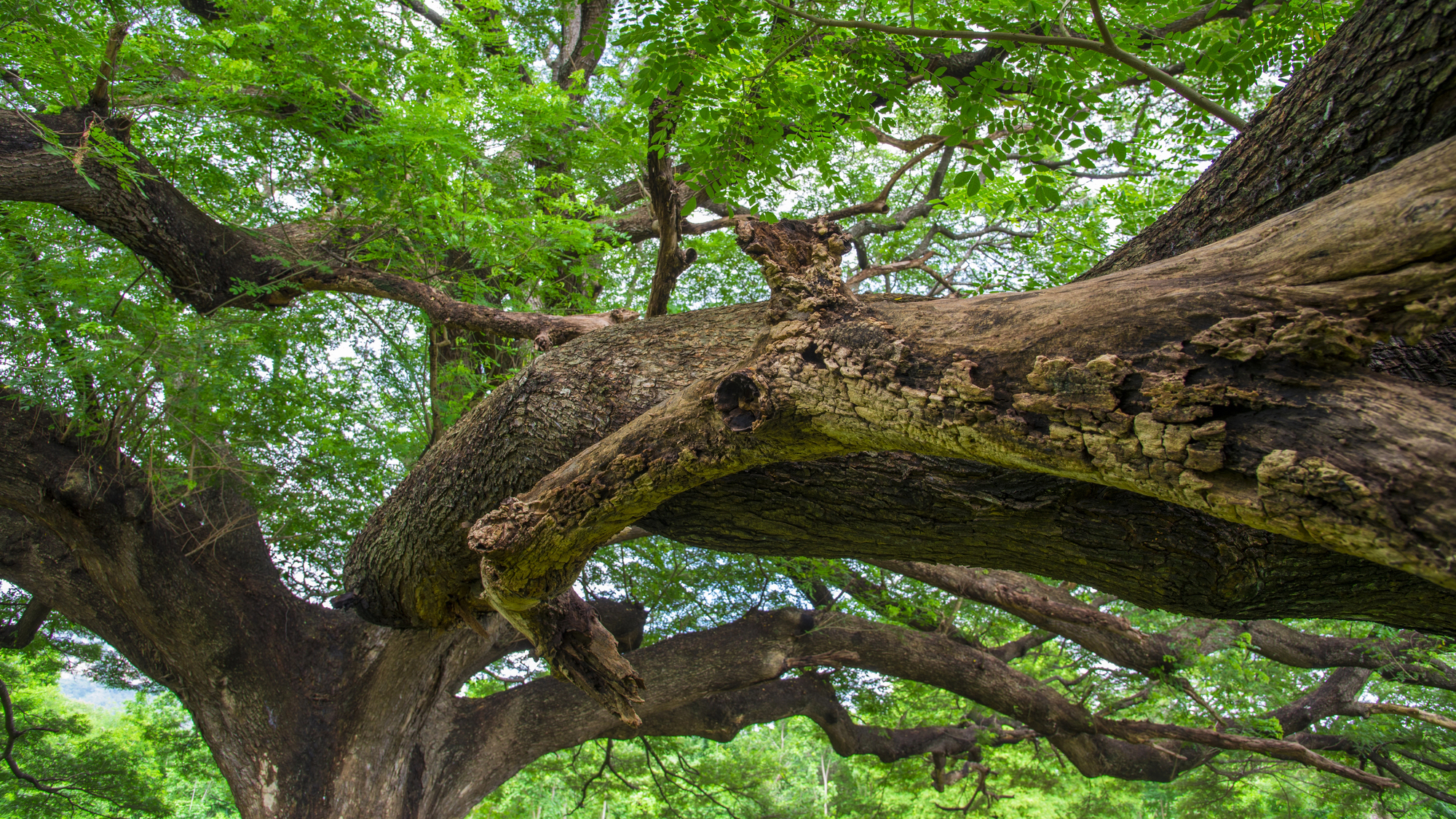Trees are a key component of a healthy planet. Through photosynthesis, trees take in atmospheric carbon dioxide and release the oxygen we need to breathe. Earth’s forests hold an estimated 861 gigatons of carbon, which is about equivalent to 100 years of anthropogenic fossil fuel emissions. Keeping trees intact ensures all that carbon stays stored and supporting careful reforestation efforts ensures additional carbon gets locked away.
If all that wasn’t enough, new research offers another reason why forests may be critical to keeping climate change in check. Trees absorb methane (CH4) through their bark, thanks to methane-hungry microbes. Through this mechanism, forests could be as much of a methane sink as soil, according to a study published July 24 in the journal Nature. The findings could help balance our understanding of Earth’s climate budget and also bolster reforestation projects.
Methane, a less-frequently discussed type of carbon emissions, is a major driver of human-caused climate change, released through industries like agriculture and natural gas extraction. Over a century, one ton of atmospheric CH4 is about 28 to 36 times as warming as carbon dioxide. Though methane is much less abundant in the atmosphere than CO2, the potent greenhouse gas is responsible for about 20 to 30 percent of global temperature increases since the industrial revolution, according to NASA estimates.

It’s long been understood that there are two primary ways methane disappears. Over a decade or so, methane molecules break down into carbon dioxide and water in the atmosphere. This is the biggest methane sink, or source of loss, in Earth’s carbon cycle. The planet’s soils represent the second largest known sink. Below ground, so-called methanotrophs (single-celled organisms that rely on methane for energy) metabolize the gas.
Yet there seems to be a third important and previously unquantified methane sink at play: trees. The bark on many tree species is also host to methanotrophs, per the new study. Added altogether, the researchers calculate that microbes inhabiting all the tree surface area worldwide are absorbing and eliminating between 24.6 and 49.9 teragrams (about 29 to 55 million tons) of the greenhouse gas each year. That puts the estimated impact of trees on par with the soil sink.
Compared with known sources and sinks of methane, top-down calculations of atmospheric concentrations indicate a mysterious missing sink. Some proportion of methane emissions are being uptaken, but scientists aren’t yet sure where. The new study could offer a big clue. “If their globally-scaled estimates are even the right order of magnitude, then they’ve demonstrated that tree methane uptake may account for one third of the global ‘missing sink’,” says Nicholas Ward, a senior research scientist and biogeochemist at the Pacific Northwest National Laboratory.
Previous research has identified the presence of methanotrophs in a few types of trees. But the new study is notable for assessing more species across multiple biomes, including tropical, temperate, and boreal forests. The research is also the first to offer a total estimate of how much methane Earth’s trees might be taking in. “We’ve found that this is actually a large-scale process that operates across the world,” says Vincent Gauci, lead study author and an ecologist and biogeochemist at the University of Birmingham in England. “On average, this makes trees about 10% better for the climate,” Gauci tells Popular Science.

Another recent spate of studies has identified certain forests as methane sources. Some trees, particularly those in wetland environments, act as conduits carrying underground methane to the surface and atmosphere. The new study doesn’t contradict these existing findings, but rather adds nuance to the question of forests’ overall role in the methane cycle, says Patrick Megonigal, an ecologist and biogeochemist at the Smithsonian Environmental Research Center, where he serves as associate director for research.
Megonigal was not involved in the new work, but has previously studied tree methane fluxes. There’s instances where trees produce methane, consume methane, and where trees do neither, he says. Drivers like soil moisture and tree anatomy might shift which occurs in a particular place. “It’s clear that this is just very dynamic,” he adds. However, the new research suggests that, on a planetary scale, trees could be taking up much more methane than they’re giving off. “It’s exciting and a major step forward in how we conceptualize the role of forests in the global methane budget,” says Megonigal. “They’ve made an important point about the potential for the woody surfaces of trees to act as a net methane sink, while also acknowledging the difficulties of making those estimates.”
Even if some trees are net sources of methane, that doesn’t mean we should cut them down, emphasize Gauci and Ward. “Society should value forests despite whether or not specific tree species emit or consume methane. This is a natural process that has occurred since long before humans existed,” says Ward. “Trees and forests are wonderful,” says Gauci. “They offer so much and they’re part of our natural world and ecosystems. We should appreciate them for their intrinsic value rather than necessarily having to tout percentages of this or that greenhouse gas.”
Gauci and a team of international scientists focused their work on non-wetland trees, which take up much more global land area than wetland forests. By placing foam and plastic gas traps around trees at various heights, they measured the methane flux occurring at different points on tree trunks in four different regions: the Brazilian Amazon, a tropical forest in Panama, a temperate deciduous forest in the UK, and a boreal forest in Sweden.
They found that, close to the soil, most trees’ bark emits a small amount of methane. However, farther up the trunk, that changes. Beginning at about breast-height, the methane flux switches over to absorption, and at ever-higher points along trunks, tree bark seems to take in more and more methane. So far, it’s unclear what role these methanotrophs are performing in a tree’s biology, if any. “It’s a really new frontier of research,” says Gauci. But it’s clear that the microbes are widespread and burning through methane at meaningful rates. Given that mature trees can be tens to hundreds of feet tall, Gauci and his colleagues estimate that the bulk of Earth’s woody surface area is absorbing methane, not emitting it.
Greenhouse gas uptake varied between ecosystems and tree species. Some species like oaks, demonstrated very little methane absorption. While others, like ashes, sycamore, and many tropical species, took in much more of the gas. Overall, tropical trees were the largest methane sinks, while temperate trees took in a smaller yet still net significant amount of CH4. In a tropical floodplain, the researchers found that whether or not trees act as a methane source or sink depends on time of year and whether the ground is inundated or dry.
Using all of this small-scale tree data, the scientists used estimates of global tree surface area to come up with an approximate range for total bark-based methane uptake. Ultimately, the numbers they came to mean that trees are even more of a climate boost than we knew, providing about 12% more carbon benefit in tropical regions and 7% more in temperate zones. “It means our trees are that much more useful and powerful than we’ve given them credit for,” says Gauci. “That has implications for forest protection, reforestation, and restoration projects,” he adds.
“This is a group that has experience in [scaling up] measurements,” notes Megonigal. “They’ve done a good job of that, in this case,” he adds. “There’s lots of uncertainty built into these data, but they acknowledge that and were conservative in their estimates.”
Despite the fact that the researchers continually documented methane absorption increasing as they measured farther up tree trunks, they only estimated mean absorption from their real measured data points, which topped out at about two meters above the forest floor. It’s quite possible that, even higher up, trees are taking in even more methane–yet Gauci and co. didn’t include that likelihood in their assessment. They also didn’t include trees in water-limited ecosystems, like savannahs, for lack of data on how methane flux unfolds in more arid habitats. Nonetheless, they still found a major potential effect.
Yet even with this abundant caution, the study has limitations. Megonigal points out that their overall sample size of about 160 trees is small. Plus, the study offers no information on what’s unfolding in the tree canopies, and what role leaves might play in methane flux. Ward notes that four locations and ecoregions can’t fully encapsulate what’s happening worldwide. “For a first order estimation these methods and conclusions are robust, but [it] by no means closes the books on global forest methane cycle,” he tells Popular Science. Additionally, since the study doesn’t include wetland trees, it’s impossible to know exactly what the net balance is between non-wetland methane uptake and wetland tree emissions. “Even if uplands and wetlands are in a net balance currently… this balance will likely change in the face of climate change,” Ward says.
“The strength of this paper is that it makes an initial case about the potential importance of this process,” says Megnonigal. But more research is needed to really home in on what trees across the whole globe are doing. “I am hopeful that this paper…will bring more people who are doing forest work off the soil and up the trees,” Megonigal adds.
Already, Gauci has a research project planned in Ghana that will assess canopy and leaf contributions to methane flux, as well as the impacts of moisture and drought conditions on absorption. The findings could further inform how we calculate our planet’s capacity to manage greenhouse gasses.
Regardless of the eventual results of that study, though, both Gauci and Megonigal caution that tree bark’s methane sink potential isn’t enough to resolve climate change on its own. Forests and reforestation “are just another part of the equation,” says Gauci. “If it can be used for good in an effort to improve uptake of methane from the atmosphere then, heck, that’d be great,” he adds. “But there’s no magic bullet.”
“At the end of the day, the solution is going to have to be regulating the greenhouse gasses that we are putting into the atmosphere,” says Megonigal. “We have to rely first on controlling our emissions, and then work with nature to do the same.”

